Out of Hand
Materializing the Post-Digital
Museum of Art and Design, New York City. October 16, 2013 – June 1, 2014
Chris Bathgate Sculpture
This is a fascinating show, and an important one. For the first time (that I know of) a major museum has embraced the concept of digitally-mediated sculpture and design, which has captured the imagination of many workers in these fields during the past decade or so, and given it the attention it deserves. Ranging from recreations of classic sculpture to algorithmically derived furniture, it highlights developments in the field that have largely been ignored by the art establishment so far. Although this is an institution that has been dedicated to hand work and artisanship, it has embraced approaches that often seem at odds with these values, giving them a chance to challenge the prevailing orthodoxies on the role of artists and their methods of making things, but leaving open the questions they raise.
The most interesting thing that this exhibition explores is the extreme variability in how different people have reacted to the opportunities afforded by advances in technology like 3D printing, CNC carving, 3D scanning, and Computer-aided design. Where one might expect a certain sameness, given any particular technique’s path of least resistance, there turns out to be a wild profusion of outcomes, depending on the sensibilities of those accessing these methodologies.
Chris Bathgate, for example, has derived a unique aesthetic from the way different metals can be combined in the hands of a skilled machinist. Looking like abstractions of mysterious machines, his austerely beautiful constructions explore the artistic possibilities unleashed by CNC machining of metals as normally employed in the manufacture of mechanical devices. Using basic techniques like lathe-turning, drilling, tapping, boring, facing, pocketing, grooving and slotting along with innovations of his own, he has built up a vocabulary of forms that while uniquely his own, has an internal logic that seems somehow inevitable.

At the other end of the aesthetic spectrum, some artists revel in computer-aided design’s new dictum, that “complexity is free.” While this is not true in all cases, it certainly comes at a reduced cost in time and effort, compared to producing it by hand. Two artists in this show take it to extremes, building multi-layered structures from 2D cut-outs that dazzle the eye, seeming like hallucinations, or visions of the architecture of other worlds. While the means they use to produce their work are similar, the artistic intent and emotional effect couldn’t be more different.
Belgian sculptor Michael Delvoye’s “Twisted Dump Truck,” for instance, looks like a nightmare Gothic eight-wheeled confessional ready to hurtle sinners off to Hell, souls beating frantically against their ornate nickel-plated steel cages. Constructed by assembling multiple intricate laser-cut panels, it hovers between the graphic and the sculptural, the traditional and the mechanical, the functional and the fantastical.
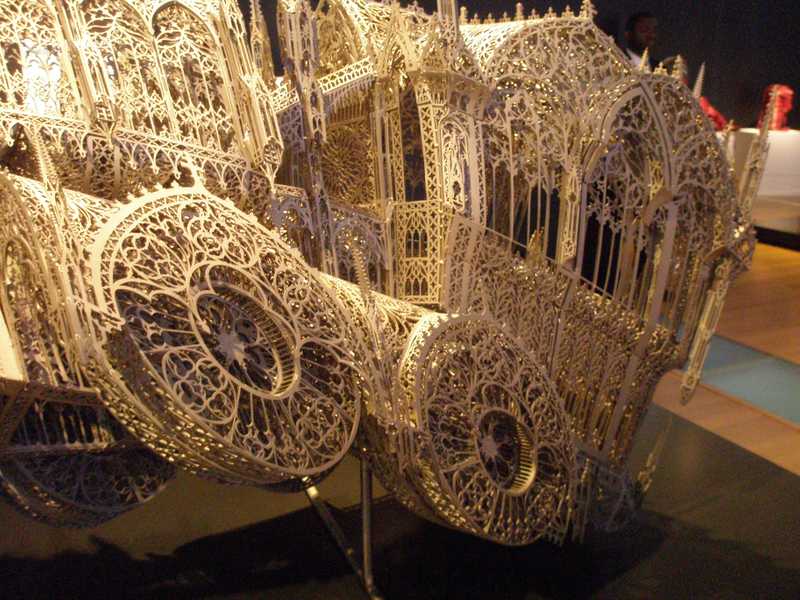
On the other hand, Michael Hansmeyer’s “Subdivided Column,” while also constructed from laser-cut 2D panels, was generated procedurally, using algorithms that mimic the morphogenic processes of nature. By applying simple mathematical rules repeatedly in an iterative process, the basic structure and fine details were simultaneously refined and elaborated. Then this architectural-scale columnar structure was cut out layer by layer in cardboard and assembled over a wooden armature, much like a 3D printing process but laminated manually. The total effect is balanced between light, airy filigree and architectural solidity, with a satisfying blend of the geometric and the organic that is interesting and different. I’d love to see a whole room or building produced this way.

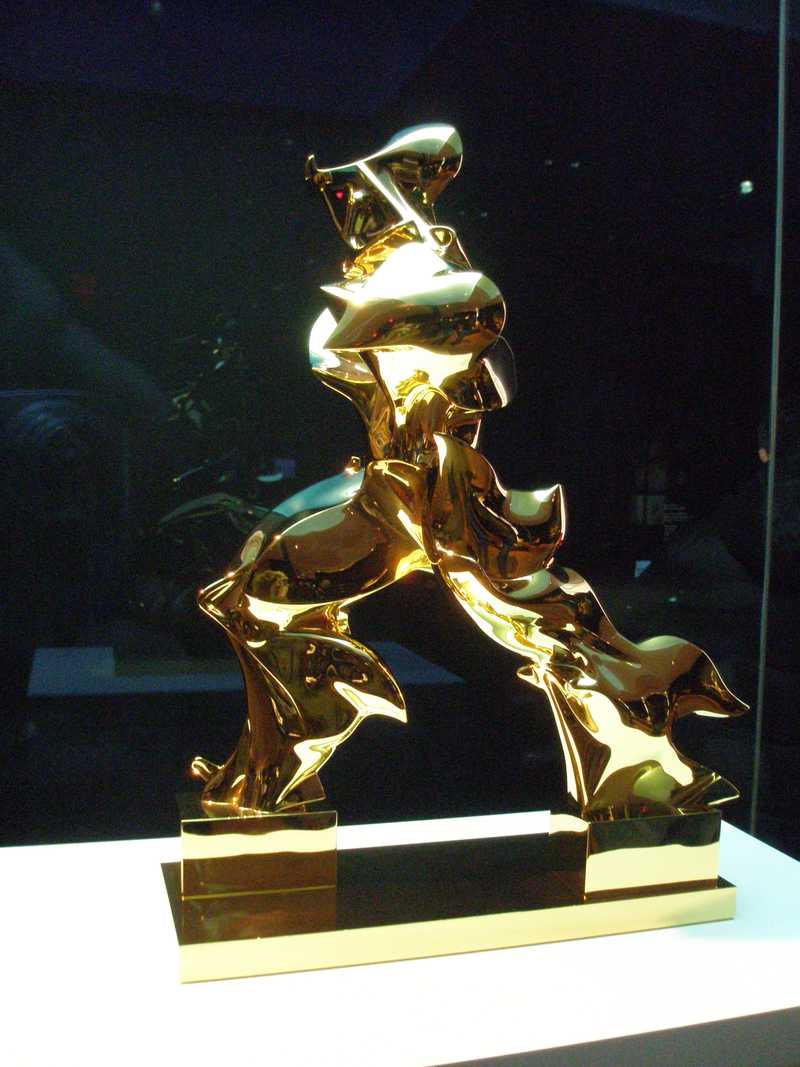
As well as using technology to bring artistic impulses into reality or to explore new ways of generating forms, some use it to re-envision the art of the past. Barry X Ball, for instance, thinks of himself as completing artistic projects that their original authors had neither the means nor the time to finish themselves to the level that’s now possible. One of the most famous icons of Modernism, for example, is Umberto Boccioni’s “Unique Forms of Continuity in Space,” a striding figure built up of shapes representing the vortices of air through which it moves. While this bronze is justly celebrated as breaking new ground in sculpture and helping to establish Futurism as an artistic movement, its surfaces, according to Ball, are not as perfect as its author intended. So, using 3D modeling techniques borrowed from the automotive industry, he set about to take them to the next level. The result, while still recognizable as the same piece (flipped left to right), does have a somewhat different quality, although I’m not sure I actually like it better. One can’t help speculating on what Boccioni would think of it.
Another approach is taken by Steve Jones in his reworking of Samuel Joseph’s 1827 white marble “Bust of Lady Belhaven.” Rather than trying to improve the original, he adds concrete representations of what’s (literally) going through her head. The weightlessness of the plastic used in the 3D printing process works well in this case, since these objects—symbolic of her interests in design, millinery, fabric, family, music, etc.—seem to float in the air around her. The result is a pastiche of the old and new, which is less jarring than one might expect, as the added forms harmonize with the original while the white resins used recall the white marble that symbolized ideal purity for Neo-Classicists like Joseph. One can envision a whole movement devoted to adding artistic commentary like this to the sculpture of the past, much like electronic sampling quotes earlier performers, embedding them in newer music.
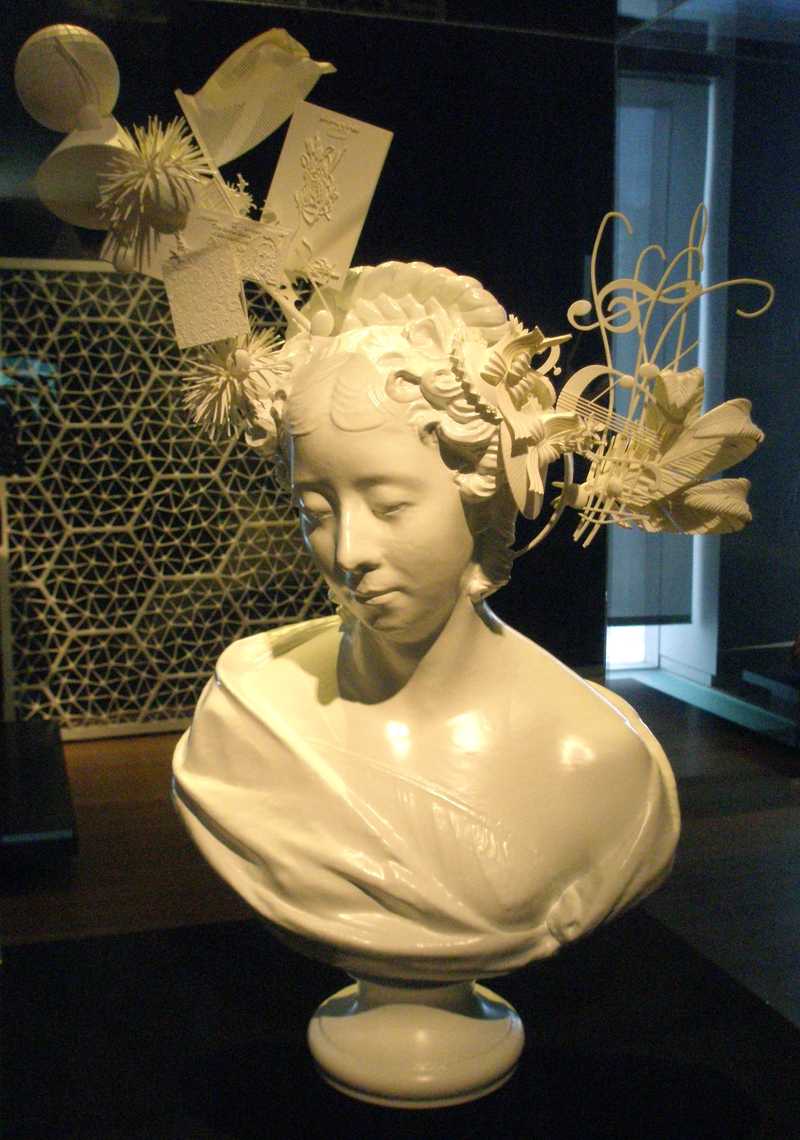
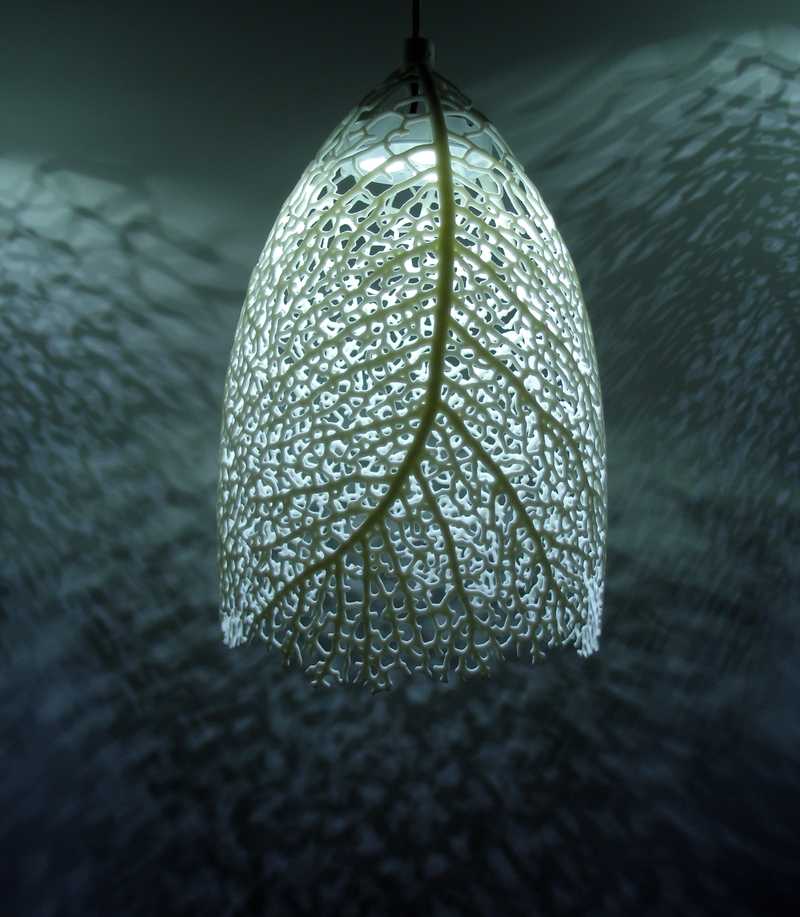
The advent of 3D printing has empowered artists and designers in various ways, mostly by freeing them from the necessity of forming materials themselves, which requires tools, studio space and quite a bit of technical knowledge. One can say that this is a bad thing, since it opens these already crowded fields to more competition from the less skilled, but this has inarguably led to many new ideas being realized that never would have otherwise seen the light of day. Service bureaus like Shapeways, one of the main sponsors of this show, have been in the forefront of bringing this ability into the hands of those without 3D printers of their own, and some of the participants in this show seem to have been selected from the roster of their customers. One of these, a design firm called Nervous System, uses Selective Laser Sintering in nylon to produce a series of “Hyphae Lamps,” the product of an algorithmic design process that mimics the formation of leaf veins in plants along lines determined by the flow of growth hormones. They have used this process to develop forms that resemble fungi, corals, diatoms and fingerprints as well as leaves. The results are quite organic-looking, and with the addition of LEDs, function very well as lamps.

While most people use the 3D printing process to produce objects directly, this has its limitations. The size of parts is restricted by the build envelope of the machine being used, and the materials are also just a small fraction of those available. Furniture designer Joris Laarman, realizing that, decided to take an opposite approach. Instead of printing a chair as a positive form, he decided to print multiple negative pieces which would bolt together to form the 79-piece mold for his “Bone Armchair.” Into this he could pour a marble-filled resin that’s much stronger than those typically available as 3D printing feedstocks, and cast the chair as a single piece. While this required a lot of hand-finishing, the stunning result speaks for itself.

As well as the design world, the world of fashion has been excited by the 3D printing revolution, although the rigidity of most printing materials available has been something of a stumbling block. Numerous “firsts” have been announced, such as the “first 3D printed bikini” or dress, or shoe. But most of the garments resemble chain mail more than fabric, and the shoes tend to be cage-like rather than comfortable-looking. Nevertheless, due to multi-material printing in soft as well as hard plastics, a new generation of 3D printed garments seem more wearable than previous attempts. A “Cape and Skirt” by Iris von Herpen and Neri Oxman is a case in point (or points, since this is an assembly of conical elements). Conceived of as “human augmentations inspired by nature” this a boldly sculptural garment, which transforms the wearer into something resembling one of Jorge Luis Borges’ “Imaginary Beings.”
Of course, imaginary beings have always been prominent in sculpture, and no modern sculptor is better at evoking them than Elona van Gent. She describes her creations straight-forwardly as “monsters,” but they are more fascinating than horrible. Realized in a 3D printing technique known as LOM (laminated object manufacturing) which involves laser-cutting and pasting sheets of paper together to build up forms, the slightly burned edges of the paper adding interest to the surfaces. The material used gives it a quality that resembles polished wood rather than the usual plastics we expect from 3D printing, giving it a nineteenth-century “steampunk” aura. The piece in this show: “WheelsClawsTeeth” seems like a monster in the process of self-assembly, each semi-animate part groping for each other until it can drag itself off and grow huge in the dark.

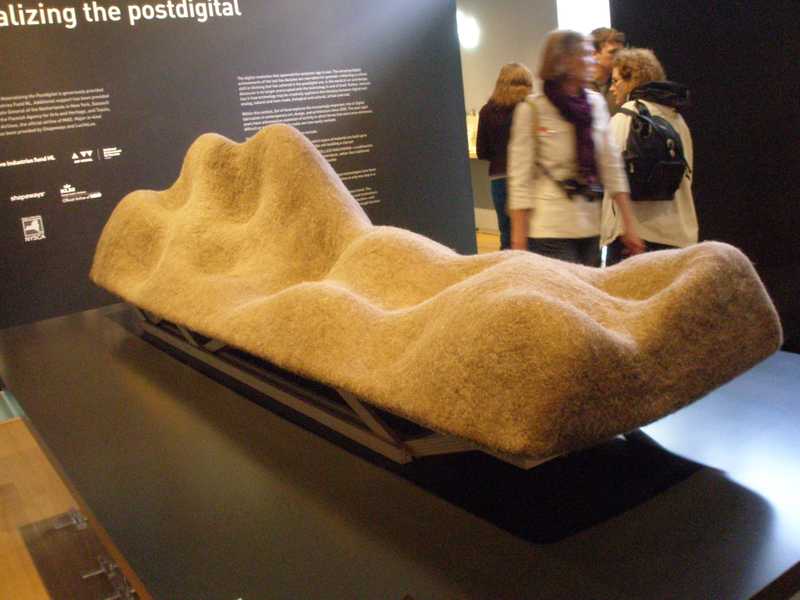
As the imagination champions, however, one would have to acknowledge Luca Maasen and Unfold, producers of the “Brain Wave Sofa.” Rather than creating a design by manipulating images on a computer, or even by programming the computer to generate forms by itself, this one was made by directly recording the varying frequency of the artist’s brainwaves with an EEG (electroencephalography) machine as he slowly opened and closed his eyes over a period of three seconds. This variable determined the depth, while the height was the varying strength of alpha-wave activity as his eyes received visual stimulation and the length was the duration in time. The 3D output of this device was sent to a CNC milling machine, which cut it out of soft foam. This was then covered with felt and secured with buttons, as in a normal upholstery process. Perhaps this points to the future of design, when it will no longer be necessary to do anything but conceive of something, whereupon a myriad of perceptive and dexterous machines will take it from there.
There were, of course, many other interesting artists and designers in this show, more than I can deal with in this short article. These were some of the highlights, in my opinion, but others would certainly make different choices. If you can’t make it to the show, or if it’s over by the time you hear about it, here’s what’s posted about it on the museum’s website, including pictures, an audio tour, printed information and some videos of artist interviews.
The museum has produced an excellent catalog for the exhibition (available on Amazon), which I highly recommend.
Andrew Werby